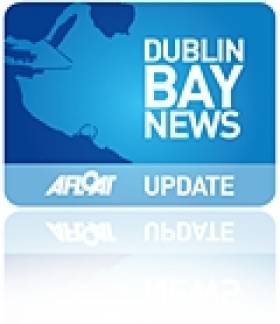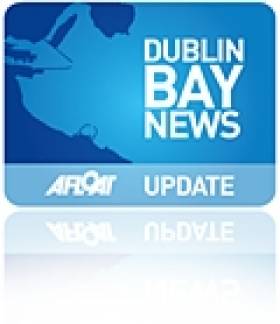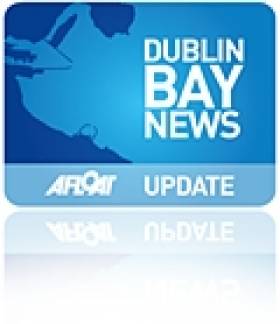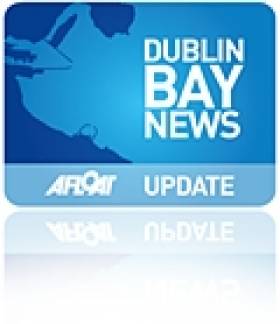Displaying items by tag: M.I.I.
T.D.’s to Strut their Stuff in aid of Maritime Museum
The fundraiser event which is in aid of the Development Fund of the museum, is to take place this Thursday evening (8 p.m.) on 10th November, in the National Yacht Club (NYC) along the waterfront of Dun Laoghaire Harbour, close to the East Pier.
Tickets costing €20 are available from the Maritime Institute of Ireland's (M.I.I.) museum office located on the top floor of the Dun Laoghaire Shopping Centre, in local fashion shops and by contacting (01) 214 3964.
At the end of last month, the M.I.I. celebrated its 70th anniversary which was founded in 1941. To read more about the museum which is undergoing renovation and due to re-open in March 2012 click HERE and to read other news and developments visit www.mariner.ie
- National Yacht Club
- Dublin Bay News
- Maritime Institute of Ireland
- Dun Laoghaire Harbour
- M.I.I.
- Richard Boyd Barrett
- nyc
- Dun Laoghaire Harbour News
- National Maritime Museum
- East Pier Dun Laoghaire
- Irish Maritime Museum's
- Independent T.D's
- Luke 'Ming' Flanagan
- Mick Wallace
- Captain Roger's
- Irish T.D's
- Dun Laoghaire Shopping Centre
- Dun Laoghaire Waterfont
- Dublin Bay yacht clubs
Lecture: The Vasa-Fifty Years On
The lectures are usually held on the third Thursday of each month and mostly in Stella Maris. The club is located between the Irish Life Mall car park (ILAC), the Customs House and Busaras. It is convenient to the Luas (Busaras stop) and the Dart (Tara Street station). For more information on visit www.mariner.ie/lectures
Dun Laoghaire’s Maritime Museum Set for Re-Opening
At the end of this month the M.I.I. will celebrate the 70th anniversary of its foundation and it is the intention of the voluntary run museum to 'officially' re-open in March 2012.
To read more about the renovation programme click HERE. If you would like to assist through voluntary work, fund-raising activities or make a donation in addition to keeping abreast of the latest developments visit www.mariner.ie
View Larger Map
Lecture: Reminiscences’ of Maritime Institute of Ireland and Maritime Museum
Kevin will be recounting his involvement with the acquisition of many of the museum's artefacts in addition to the part he has played in representing the M.I.I. on such issues as sail-training, and the National Monuments Legislation with relation to the Armada finds in Ireland. In addition, Kevin is an experienced yachtsman and he will be touching on that subject too during the evening.
The museum which is situated in the former Mariners Church, Haigh Terrace is due be re-opened with a 'preview' from 16 October 2011 to mark the M.I.I.'s 70th anniversary. The museum is due to be officially opened in Easter 2012. For more about the M.I.I., its museum and activities www.mariner.ie
Heritage Week: Maritime Lectures In Dun Laoghaire
12.30 – 1.30 pm. Neutral Ireland's Role in the Sinking of the Bismarck, May, 1941 By Dr. Michael Kennedy, Executive Editor, Documents on Irish Foreign Policy, Royal Irish Academy.
1.30 – 2.30 pm. Traditional Boats of Ireland. - Wooden workboats from all the Maritime Counties of Ireland. By Darina Tully, Lecturer and Maritime Archaeologist.
2.30 – 3.30 pm. Too Many Bags in the Lifeboat. A Lifeboat Tragedy at Bray 1876 By James Scannell, Lecturer and P.R.O of the Old Dublin Society.
4.00 – 5.00 pm. Maritime Guinness, The Ships, Yachts and Barges of the Guinness Dynasty. By Dr. Edward Bourke, Diver, Maritime Historian and Author of "Guinness, the Family, the Business and the Black Stuff"
5.00 – 6.00 pm. Ireland's Armada Heritage. The Story of the Spanish Armada of 1588. The discoveries of the wrecks on the Irish Coast and the recovery of artifacts. By Cormac Lowth, Lecturer, Author and Diver.
Further information Barney Yourell 087 900 7466 No seminar charge – donations accepted. Information in general on the Maritime Institute of Ireland can be found on http://www.mariner.ieand for other nationwide events of the Heritage Week visit www.heritageweek.ie
- Events
- Dun Laoghaire Harbour
- M.I.I.
- Dun Laoghaire Harbour News
- Event news
- National Heritage Week
- Heritage Week
- Maritime Lecture Seminar
- Spanish Armada
- Eblana Centre Dun Laoghaire
- Maritime Insitute of Ireland
- Bismarck
- Traditional Irish wooden boats
- Guiness ships
- Guinness barges
- Darina Tully
- Irish heritage boats
Dun Laoghaire Harbour's Sunday 'Family-Funday'
Opening times are 11am to 5pm and the entry fee is €3 for adults and children go free. The Funday is to help raise funds to support the local national maritime museum of Ireland in Dun Laoghaire. The Maritime Institute of Ireland is a registered charity, which run the museum through volunteers. In addition they host lectures, represent maritime interests and operate a museum and library.
The museum is housed in the former Mariners Church and is currently closed due to renovation and improvement works. There will be a 'soft launch' or 'preview' of the museum from October to mark the M.I.I.'s 70th anniversary.
Next year the museum is due to be officially re-opened during the Easter. The M.I.I. welcomes new members, volunteers and donations. For further information visit www.mariner.ie
- Pirates
- Carlisle Pier
- Dublin Bay News
- Maritime Institute of Ireland
- Dun Laoghaire Harbour
- M.I.I.
- Mariners Church Dun Laoghaire
- Dun Laoghaire Harbour News
- Irish maritime museums
- Family Funday
- DART Dun Laoghaire
- DART railway
- Pirats and Princesses competition
- Irish maritime interests
- Irish maritime lectures
- Irish maritime library
- National Maritime Museum of Ireland
- NMMI
‘Family Fun Day’ in Dun Laoghaire
Funds raised will go to the maritime museum which is housed in the former Mariners Church, which is run by the Maritime Institute of Ireland (M.I.I.). The museum is currently closed due to continued renovation and improvement works.
There will be a 'soft launch' or 'preview' of the maritime museum from October to mark the M.I.I.'s 70th anniversary. Next year the museum is due to be officially re-opened during the Easter. The M.I.I. welcomes new members, volunteers and donations to assist in the museum. For information visit www.mariner.ie
Heritage Week: Maritime Lecture Seminar Day
Below is listing of the lecture programme and times.
12.30 – 1.30 pm. Neutral Ireland's Role in the Sinking of the Bismark, May, 1941. By Dr. Michael Kennedy, Executive Editor, Documents on Irish Foreign Policy, Royal Irish Academy.
1.30 – 2.30 pm. Traditional Boats of Ireland. - Wooden workboats from all the Maritime Counties of Ireland. By Darina Tully, Lecturer and Maritime Archaeologist.
2.30 – 3.30 pm. Too Many Bags in the Lifeboat. A Lifeboat Tragedy at Bray 1876. By James Scannell, Lecturer and P.R.O of the Old Dublin Society.
3.30 – 4.00pm. Model Boats, A short talk to accompany the exhibition. By Garry Mooney secretary of the Irish Model Boat Club.
4.00 – 5.00 pm. Maritime Guinness, The Ships, Yachts and Barges of the Guinness Dynasty. By Dr. Edward Bourke, Diver, Maritime Historian and Author of "Guinness, the Family, the Business and the Black Stuff"
5.00 – 6.00 pm. Ireland's Armada Heritage. The Story of the Spanish Armada of 1588.The discoveries of the wrecks on the Irish Coast and the recovery of artifacts. By Cormac Lowth, Lecturer, Author and Diver.
For further information contact Barney Yourell Mob: 087 900 7466 No seminar charge – donations accepted
Information in general on the Maritime Institute of Ireland can be found on www.mariner.ie and for all the other events held during the National Heritage Week go to www.heritageweek.ie/
- Dublin Bay News
- Maritime Institute of Ireland
- Irish Model Boat Club
- Dun Laoghaire Club
- Dun Laoghaire Harbour
- M.I.I.
- Dun Laoghaire News
- RNLI Lifeboats
- National Heritage Week
- Heritage Week
- Maritime Lecture Seminar
- Sinking of the Bismark
- Traditional Wooden Irish Boats
- Guinness Ships
- Model Boats
- Ireland's Armada Heritage
- Spanish Armada
- Dun Laoghaire Maritime Museum
A Brighter Future for Dun Laoghaire Maritime Museum
For several years the museum has been closed for vital repair and extensive renovation work. In October the M.I.I. will celebrate their 70th anniversary which will be marked by a 'soft launch' and in the following year the museum is to be officially re-opened in Easter 2012.
'Bag' that Maritime Museum
A 'Bag-Packing Day' in aid of the Maritime Museum in Dun Laoghaire is to start tomorrow, writes Jehan Ashmore.
The fund-raising activity will also run on the Friday and Saturday at the Tesco Bloomfield Shopping Centre off Lower Georges Street.
Volunteers are invited to assist in providing two hours of their time to help raise funds for the Maritime Museum which is currently closed due to ongoing renovation work.
For further information please call (01) 214 3964 or email: [email protected]
The museum is located in the former Mariners Church and is run by the Maritime Institute of Ireland (M.I.I.). The museum is to be officially reopened in March 2012, however they intend to be open to the public before their 70th anniversary in October 2011.
Information about the M.I.I. and the museum which welcomes new members can be found on www.mariner.ie






































































